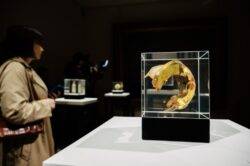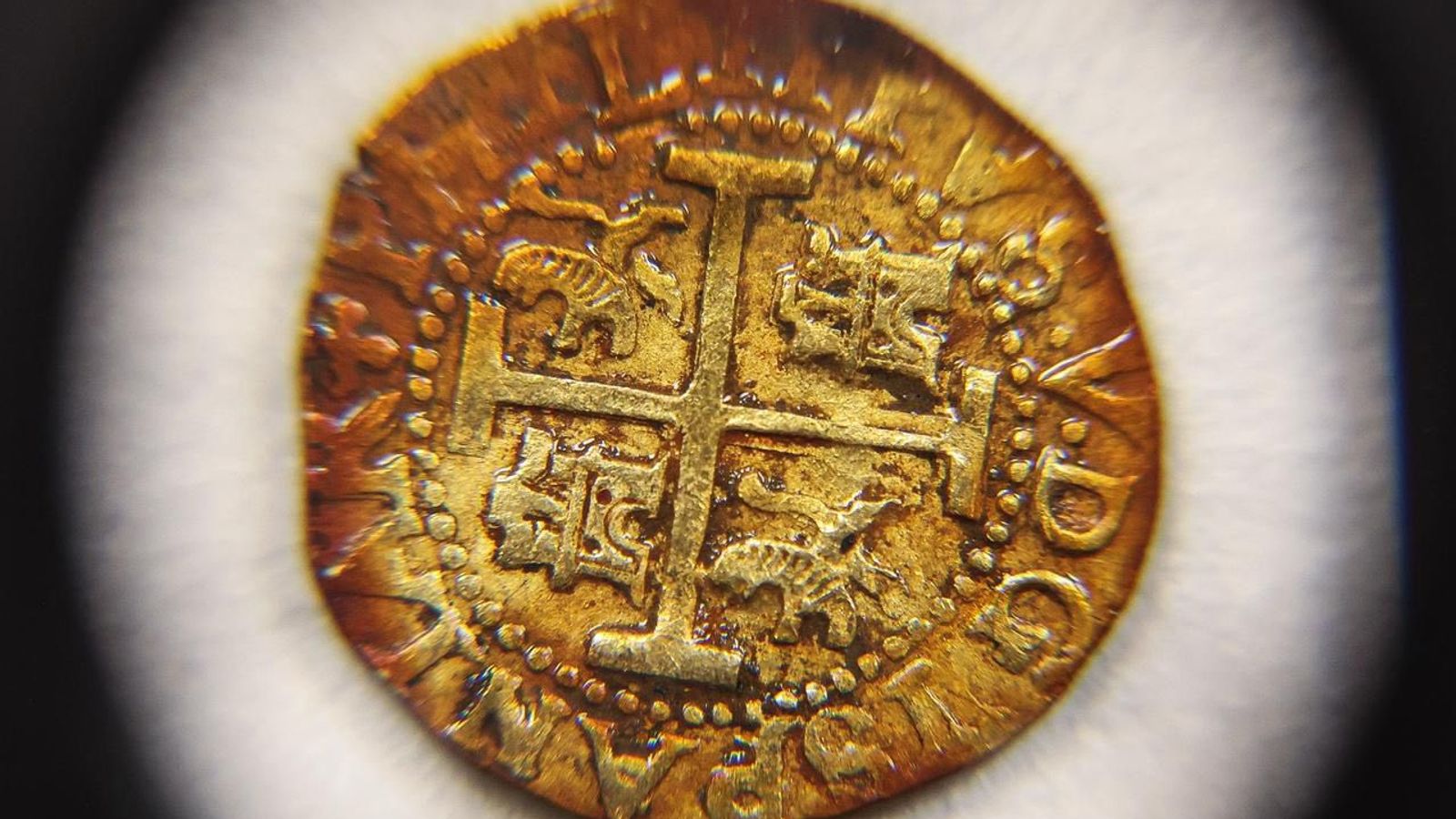A bottle of flour, a soldier’s hat, a well-used pencil. Everyday objects that sit suspended in space and time, frozen in clear cubes across two museums in Kyiv and Lviv.
These unremarkable artefacts act as contemporary exhibits; reminders of lives lost and families broken in Ukraine.
The items are part of the War Fragments project, which offers powerful visual representation of the impact of the war on people’s lives. Each cube represents a story of survival, capturing the personal experiences of those affected.
300 objects were taken from de-occupied towns and villages around Ukraine, the territories that suffered the most and each, sunk in epoxy resin, is accompanied by a unique story of the horrors of war. Among them a pair of baby socks, artillery found in a private garden and a small Ukrainian flag.
With the cubes eventually being auctioned off, the funds will go to children and military men hurt in the conflict.
Tetyana Fiks, one of the exhibition’s co-founders, tells Metro.co.uk: ‘This project means a lot to people.
‘We all understand what these stories are telling. When you live in Ukraine and you have missile attacks almost every day, all parts of Ukraine feel it. The war is inside every one of us.’
Here, we take a look at just some of the pieces on display and get a glimpse of the harrowing stories behind them.
During a storm in January 2022, a crucifix fell from one of the domes of St. Sophia Cathedral in Kyiv. Many people took it as a bad sign. Ukrainians did not know at that time of the horrors that would befall them. The cross was restored, with this one fragment, known as ‘Messenger’, frozen in resin as a reminder of Kyiv’s strong and proud past (Picture: The War Fragments)
Serviceman Ungb Azov donated this military hat, seen on the left, which he kept throughout a period of Russian captivity after he fought to defend Mariupol. He told the project of the unimaginable scenes of injury, death and destruction he saw, telling one particularly horrific tale of how ‘one married couple was killed in their apartment — vilely, insidiously, from a tank.’ (Picture: The War Fragments)
A bottle of flour represents the humanitarian help given to stricken communities throughout the conflict. This cube tells the story of two children who ended up living without their mother during the first days of the war. Having run out of food and money, they lived off flour for two weeks until a volunteer aid worker arrived to help (Picture: The War Fragments)
We know little about the story of this magnet. Someone must have brought it from Venice. Perhaps it was a family that loved to travel and dreamed of seeing the world,’ says one contributor, who found it when searching for bodies amid the destruction in the city of Borodyanka. He adds: ‘You would go to look at these bodies searching and hoping that you would find your relatives…After the air bomb, after this air strike, it is difficult to call what is left a body. It’s simply terrifying.’ (Picture: The War Fragments)
This key was donated by Samoilenko Illia as a symbol of the invincibility of Ukrainian soldiers. Samoilenko, an amputee who fought in the Battle of Mariupol, the Battle of Azovstal, and who was held hostage by Russian forces, hid this handcuff key in his prosthetic arm throughout his captivity. Samoilenko is now deputy commander of his brigade (Picture: The War Fragments)
Like all Ukrainians, Serhiy Maidukov, a well-known illustrator, felt impending threat and anxiety when war broke out. He expressed his thoughts and feelings through his ‘Postcards from Kyiv’ series of drawings which were published in the New Yorker. This cube contains a pencil with which he drew from the trenches of the front line (Picture: The War Fragments)
This cube contains an element of the Mriya (Dream) air plane, which was part of a local victory of the Ukrainian Armed Forces over the Russian army in Kyiv region in spring 2022. The An-225 plane was destroyed but a new one in construction, with this piece representing the dream of rehabilitation after injury (Picture: The War Fragments)
‘One dog was just skin and bones — she had a stroke and could barely walk. She died near me and I buried it.’ These are the words of Olena Berlizeva from Northern Saltivka, among the most destroyed districts in Ukraine. She left her home amid shelling, returning to find her two starving dogs on the brink of death. She donated this fragment of a telephone, found amongst the wreckage (Picture: The War Fragments)
Tetyana Fiks, one of the exhibition’s co-founders, says this piece resonates with her. It shows a crucifix, donated by a doctor serving with the army. She says: ‘He is on the front line. He told us his story and he gave us this cross which he had been wearing. He told us he is not sure if he will return, and he wants a part of his story to remain. It was very hard to sit near him and not know whether he is coming back.’ (Picture: The War Fragments)
The exhibition contains a number of hearts which have come to symbolise the love, strength and unity of the Ukrainian people. Tetyana adds: ‘The heart shape is a symbol across the world that we all understand and it means the same in Ukraine. It is very difficult emotionally for us because we have been in the war for a long time. That is why we are all trying to grab something that we can hold on to. The heart is a positive symbol during a difficult time.’ (Picture: The War Fragments)
For more information about the exhibition, click here.
Snapshot
Welcome to Snapshot, Metro.co.uk’s picture-led series bringing you the most powerful images and stories of the moment.
If you have a photo collection you would like to share, get in touch by emailing [email protected]
MORE : Wrongful convictions and desperate food thefts – the stories behind vintage police mugshots
MORE : Snapshot: The ISIS survivors rebuilding their lives
MORE : Snapshot: Boob boxes and glitter galore – behind the scenes with Queenz
300 objects taken from de-occupied places around Ukraine now make up an exhibition – among them the bottle of flour that children had survived on after their mother went missing.





